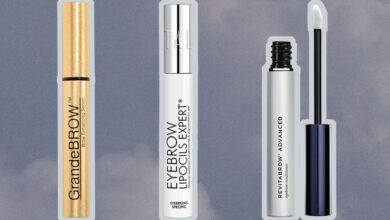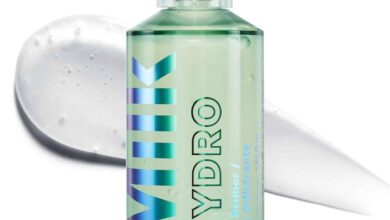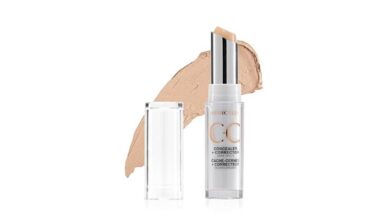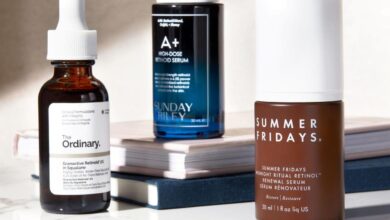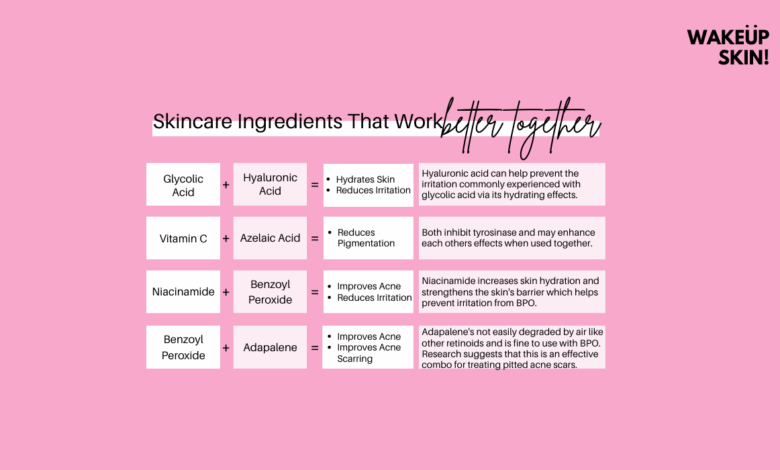
All your questions about skin care layering answered sets the stage for a deep dive into the art of layering your skincare routine. This guide breaks down everything from the basics of layering to advanced techniques and troubleshooting common issues. We’ll explore different skin types, product categories, and layering strategies to help you build a personalized routine that works best for your unique needs.
From choosing the right cleanser to understanding the importance of product compatibility, we’ll cover it all. We’ll delve into specific product recommendations, different layering techniques, and common mistakes to avoid. Get ready to unlock the secrets of effective skin care layering and achieve your best, most radiant skin.
Introduction to Skin Care Layering
Skin care layering is a strategic approach to applying different skincare products in a specific order to maximize their effectiveness and benefits. This method allows for a more targeted approach to skin concerns, addressing multiple issues simultaneously and enhancing the overall health and appearance of the skin. It’s more than just putting on multiple products; it’s about understanding how each product works in conjunction with others to achieve optimal results.Layering allows for the gradual build-up of beneficial ingredients, from gentle cleansing to potent serums, ultimately leading to a more radiant and healthy complexion.
By carefully selecting and applying products in the correct order, individuals can create a personalized routine tailored to their specific skin type and concerns.
Fundamental Principles of Layering
The order of application is crucial in skin care layering. Products are applied in a specific sequence to allow each product to work effectively. A crucial principle is that lighter products should be applied before heavier ones. This ensures that the lighter products, like serums, can penetrate the skin more easily before being covered by heavier moisturizers.
Order of Application
The typical order of application in a comprehensive skin care routine involves several key steps. Starting with cleansing, the routine proceeds through toning, serums, treatments, and finally moisturizing.
- Cleansing: The first step is to remove dirt, makeup, and impurities from the skin’s surface. This step prepares the skin for the subsequent steps in the routine. Cleansers come in various forms, such as foams, gels, oils, and balms, each designed to cater to different skin types and concerns.
- Toning: After cleansing, toning helps to balance the skin’s pH levels. Toners can also target specific skin concerns, such as dryness or excess oil. This step helps to prepare the skin for the subsequent application of serums and treatments.
- Serums: Serums are concentrated solutions containing active ingredients that address specific skin concerns, such as wrinkles, hyperpigmentation, or acne. The active ingredients in serums are designed to penetrate the skin more deeply than other products, enabling them to work more effectively on a cellular level. Apply serums after toners, as they often contain active ingredients that can be deactivated by certain products or compromised by their application on a compromised skin surface.
- Treatments: Treatments are often used to target specific concerns. These can include masks, spot treatments, or other topical products. Their application depends on the specific concern and the product’s instructions.
- Moisturizing: The final step in the routine is moisturizing. Moisturizers hydrate the skin and protect it from environmental stressors. Different moisturizers are available to suit varying skin types and concerns.
Skin Types and Layering Adjustments
Different skin types require specific adjustments to the layering routine. Understanding the needs of your skin type is paramount to a successful and effective layering approach.
| Skin Type | Layering Adjustments |
|---|---|
| Oily Skin | Prioritize oil-control products, light moisturizers, and water-based serums. |
| Dry Skin | Emphasize hydrating serums and creams, and heavier moisturizers. |
| Combination Skin | Tailor the routine to address the specific needs of both dry and oily areas. |
| Sensitive Skin | Choose gentle, fragrance-free products and avoid harsh ingredients. |
Product Compatibility
Product compatibility is vital in a layering routine. Products that are not compatible can interact negatively, potentially leading to irritation or reduced effectiveness. It’s crucial to select products that complement each other and do not interfere with the absorption or efficacy of other products.
“Careful consideration of product compatibility is essential for a successful skin care layering routine.”
Product Categories in Layering
Skincare layering is a powerful technique for maximizing the effectiveness of your products. By understanding the function of each product and its optimal placement in your routine, you can achieve a more comprehensive approach to skin health. This involves carefully considering not only the products themselves, but also their interactions and how they work together.
Product Categorization and Application Order
Different skincare products serve distinct purposes, and their order of application plays a crucial role in their effectiveness. This table Artikels the key product categories, their functions, benefits, and ideal application order.
| Product Name | Function | Benefits | Order of Application |
|---|---|---|---|
| Cleanser | Removes dirt, oil, makeup, and impurities from the skin’s surface. | Prepares skin for subsequent products by eliminating surface buildup, leaving it clean and ready for absorption. | First |
| Toner | Balances skin’s pH, removes residual cleanser, and prepares skin for serums and moisturizers. | Helps restore the skin’s natural moisture barrier, reducing irritation and promoting absorption of subsequent products. | Second |
| Serum | Delivers concentrated ingredients to address specific skin concerns. | Targets wrinkles, blemishes, hyperpigmentation, and other concerns depending on the specific ingredients. | Third |
| Moisturizer | Hydrates and protects the skin’s moisture barrier, locking in hydration and preventing moisture loss. | Provides a protective layer, maintaining skin’s elasticity and preventing dryness. | Fourth |
| Sunscreen | Protects skin from harmful UV rays, preventing premature aging and skin damage. | Reduces the risk of sunburns, hyperpigmentation, and skin cancer. | Last |
Cleanser Types and Skin Suitability
The choice of cleanser depends on your skin type and concerns. Different types of cleansers offer varying benefits and are suited for different skin needs. The table below provides a comparison of different cleanser types.
So, you’ve got all those burning questions about skin-care layering? No worries, I’ve got you covered! While planning my next trip to Koh Samui, Thailand (check out my Koh Samui Thailand guide for some amazing tips!), I realized how much I needed a solid skin-care routine. And now, I’m ready to share everything I’ve learned to answer all your skin-care layering questions!
| Cleanser Type | Skin Type Suitability | Description | Benefits |
|---|---|---|---|
| Foaming | Oily or combination skin | Creates a rich lather, effectively removing excess oil and impurities. | Excellent for removing excess oil, suitable for oily skin. |
| Gel | Normal to oily skin | Lightweight and non-greasy, effectively cleanses without over-drying. | Gentle on the skin, suitable for sensitive skin types. |
| Oil | Dry or sensitive skin | Uses oil to dissolve makeup and impurities, leaving skin soft and hydrated. | Effective at removing makeup and impurities without stripping the skin’s natural oils. |
Serums: Targeting Specific Concerns
Serums are concentrated formulas designed to address specific skin concerns. Their role in layering is to provide targeted treatments that work synergistically with other products in your routine. For instance, a vitamin C serum can help brighten skin, while a retinol serum can promote cell turnover.
Moisturizer Types and Skin Suitability
Moisturizers replenish and maintain skin hydration. Choosing the right moisturizer depends on your skin type and desired effects.
| Moisturizer Type | Skin Type Suitability | Properties | Benefits |
|---|---|---|---|
| Cream | Dry or mature skin | Rich in emollients and oils, providing intense hydration and nourishment. | Excellent for deeply hydrating and nourishing dry or mature skin. |
| Gel | Oily or acne-prone skin | Lightweight and non-comedogenic, preventing clogged pores and providing light hydration. | Suitable for oily or acne-prone skin, preventing excess oiliness. |
| Lotion | Normal to dry skin | Balances hydration and nourishment, providing a smooth and comfortable texture. | Suitable for most skin types, providing a comfortable balance of hydration. |
Sunscreen Importance and SPF Ratings
Sunscreen is a crucial component of any skincare layering routine. It protects the skin from harmful UV rays, preventing premature aging, sunburns, and long-term damage.
| SPF Rating | Protection Level | Description |
|---|---|---|
| 15-30 | Moderate Protection | Suitable for everyday use, offering protection against moderate sun exposure. |
| 30-50 | High Protection | Provides enhanced protection against stronger UV rays, ideal for prolonged sun exposure. |
| 50+ | Very High Protection | Offers the highest level of protection against UV rays, recommended for sensitive skin or extended sun exposure. |
Layering Techniques and Strategies: All Your Questions About Skin Care Layering Answered
Mastering the art of skin care layering isn’t just about piling on products; it’s about crafting a personalized routine that addresses your unique skin concerns. This involves understanding not only the products themselves but also how they interact and how to adapt your approach based on your skin type and current needs. By carefully considering layering techniques, you can unlock a more effective and efficient skin care regimen.Different skin types require different approaches.
A sensitive skin type may need a gentler approach, avoiding strong active ingredients, while acne-prone skin might benefit from targeted treatments. By tailoring your layering routine to your specific skin type and concerns, you’ll be well on your way to achieving your skin goals.
Layering for Acne-Prone Skin
Acne-prone skin often requires a targeted approach, focusing on controlling oil production, reducing inflammation, and preventing further breakouts. A crucial aspect of layering for acne is choosing products that are non-comedogenic and lightweight, avoiding ingredients that could clog pores. Start with a gentle cleanser to remove impurities without stripping the skin’s natural oils. Next, use a toner to balance the skin’s pH.
A lightweight serum with salicylic acid or benzoyl peroxide can target blemishes, followed by a moisturizer to maintain hydration without exacerbating oil production. Finally, a lightweight sunscreen is essential to protect against environmental damage.
Layering for Sensitive Skin
Sensitive skin requires a gentler approach that prioritizes avoiding irritation and inflammation. Begin with a mild, fragrance-free cleanser to cleanse the skin without disrupting its natural moisture barrier. Follow with a fragrance-free toner to balance the skin’s pH. Next, a lightweight, hydrating serum with soothing ingredients like aloe vera or chamomile can be incorporated. A hypoallergenic moisturizer that provides hydration without clogging pores is essential.
Lastly, a broad-spectrum sunscreen with minimal ingredients is vital for protection from the sun’s harmful rays.
Layering for Mature Skin
Mature skin often benefits from layering products that address specific concerns such as wrinkles, fine lines, and loss of elasticity. Start with a gentle cleanser formulated for mature skin to remove impurities without over-drying. A hydrating toner can help restore moisture balance. A serum with ingredients like retinol or hyaluronic acid can stimulate collagen production and hydrate the skin.
A rich, moisturizing cream with antioxidants can further support skin elasticity and firmness. A broad-spectrum sunscreen with antioxidants is essential for protecting the skin from sun damage.
Tailoring Layering for Specific Skin Concerns
Skin concerns like dryness, breakouts, and hyperpigmentation require customized layering routines. For dry skin, focus on hydrating products at each stage. A hydrating cleanser, toner, and serum are key, followed by a rich moisturizer and occlusive products like oils to lock in hydration. For breakouts, choose products with active ingredients like salicylic acid or benzoyl peroxide, carefully following the instructions for usage and potential side effects.
For hyperpigmentation, incorporate brightening serums with ingredients like vitamin C or kojic acid, and always use sunscreen to prevent further discoloration.
Understanding Individual Skin Reactions
Individual skin reactions vary. It’s crucial to observe how your skin responds to different products and adjust your layering routine accordingly. Start with a small amount of each product and gradually increase the application amount as tolerated. If you experience any irritation, discontinue use and consult a dermatologist. Keep a detailed log of your products and their effects to identify potential triggers and build a routine that supports your skin’s unique needs.
Active Ingredient Interactions
Active ingredients in skin care products can interact with each other. Some ingredients may enhance the effectiveness of others, while others may interfere or even cancel out each other’s benefits. For example, retinol and vitamin C can be powerful antioxidants, but applying them together may increase the risk of skin irritation. Always check for potential interactions between ingredients before combining them in your layering routine.
It is important to follow instructions on the product labels and to consult with a dermatologist for any questions about potential interactions.
Common Mistakes and Solutions

Layering skincare products can be a powerful way to achieve optimal results, but it’s easy to make mistakes that can hinder your progress or even cause irritation. Understanding common pitfalls and their solutions is crucial for a successful skincare routine. This section delves into common errors, their causes, and how to troubleshoot any resulting skin issues.Improper layering can lead to ineffective product absorption, clogged pores, and even allergic reactions.
Knowing the order and types of products you use is key to maximizing the benefits and minimizing the risks. By understanding these common errors, you can fine-tune your approach and create a personalized routine that works best for your skin type and concerns.
Incorrect Product Sequencing
Many people apply products in a haphazard order, failing to understand the importance of product viscosity and absorption rates. Heavier, oil-based products, such as serums with high oil content or moisturizers, should generally be applied before lighter, water-based products. This allows the heavier products to fully absorb into the skin before the lighter products are applied.
- Applying sunscreen last: Applying sunscreen last can lead to its ingredients not being absorbed properly and can decrease its effectiveness, potentially leaving the skin exposed to UV rays. It is crucial to apply sunscreen before any other products to ensure its complete coverage and absorption.
- Mixing incompatible ingredients: Certain ingredients react negatively when combined, leading to irritation or breakouts. For example, combining highly acidic toners with harsh cleansers can disrupt the skin’s natural pH balance. Understanding the chemical makeup of your products is key to avoiding these issues.
Ignoring Skin Type and Concerns
A one-size-fits-all approach to skincare layering is ineffective. People often neglect to tailor their layering routine to their specific skin type and concerns. Oily skin needs different products than dry skin, and someone with acne will need a different approach than someone with hyperpigmentation.
- Using products unsuitable for your skin type: Applying products not suited to your skin type can lead to irritation, breakouts, or other negative effects. For example, using a thick, heavy moisturizer on oily skin can exacerbate oil production, leading to clogged pores and blemishes. Consulting a dermatologist or skincare professional to determine your specific skin type and its requirements is recommended.
- Neglecting specific concerns: If you have acne, using products that do not address acne-causing bacteria or inflammation will not yield the desired results. Similarly, for hyperpigmentation, using products with ingredients like vitamin C or retinol is essential to combat the issue.
Insufficient Product Amounts
Applying too little of a product can significantly reduce its effectiveness. Conversely, applying too much can lead to clogging pores and skin irritation. Finding the right amount for your skin type and product is crucial.
- Applying insufficient product amount: Applying too little product can result in an ineffective treatment, leaving the desired issue unresolved. It’s vital to apply the correct amount of each product according to the manufacturer’s instructions and your skin’s needs.
- Applying excessive product amount: Overapplying can lead to clogged pores, skin irritation, and potential breakouts. It’s important to use a pea-sized amount for serums and a dime-sized amount for moisturizers, and adjust based on your skin’s needs.
Troubleshooting Skin Issues
If you experience irritation, breakouts, or other adverse reactions after layering, it’s essential to identify the culprit.
- Identifying the source of irritation: The best way to identify the source of irritation is to eliminate products one by one. Start by removing any new products from your routine and see if the issue subsides. If it does, the new product is the likely culprit. If the issue persists, you might need to consult a dermatologist.
- Addressing potential allergic reactions: Allergic reactions can manifest in various ways, from redness and itching to hives and swelling. If you suspect an allergic reaction, discontinue use of the suspected product immediately and consult a dermatologist.
Advanced Layering Strategies
Taking your skincare routine to the next level involves understanding how to tailor your layering approach to address specific skin concerns. This advanced approach goes beyond the basics, focusing on targeted solutions for acne, aging, or hyperpigmentation. It’s about combining products with complementary actions for optimal results.This section delves into sophisticated layering techniques, highlighting the best practices and procedures for achieving targeted outcomes.
We’ll explore how to incorporate masks and other treatments seamlessly into your existing routine, ensuring maximum efficacy and minimal irritation.
Layering for Acne-Prone Skin
Acne-prone skin requires a strategic approach to layering. The goal is to cleanse effectively, control oil production, and prevent further breakouts while promoting healing. A crucial element is using products that are specifically formulated for acne-prone skin, containing ingredients like salicylic acid or benzoyl peroxide.
- Gentle Cleansing: Begin with a gentle, foaming cleanser designed for acne-prone skin. Avoid harsh scrubbing that can irritate the skin. A foaming cleanser effectively removes excess oil and impurities without disrupting the skin’s natural barrier.
- Spot Treatment: Incorporate a targeted spot treatment containing salicylic acid or benzoyl peroxide to address active breakouts. Apply this directly to the affected area after cleansing.
- Moisturizer: A lightweight, oil-free moisturizer can prevent dryness and soothe the skin without clogging pores. Look for non-comedogenic options to avoid further breakouts.
Addressing Hyperpigmentation
Hyperpigmentation, characterized by dark spots or discoloration, requires a multi-pronged approach that combines brightening ingredients and protective measures. Effective layering involves ingredients like vitamin C, kojic acid, or arbutin.
- Vitamin C Serum: Apply a vitamin C serum in the morning to help lighten dark spots and promote even skin tone. Vitamin C is a potent antioxidant that helps protect the skin from further damage. Use a serum with a concentration appropriate for your skin type.
- Sunscreen: A broad-spectrum sunscreen with an SPF of 30 or higher is crucial. Sunscreen shields the skin from harmful UV rays that can worsen hyperpigmentation and contribute to skin damage.
- Exfoliation: Gentle exfoliation can help remove dead skin cells that can contribute to the appearance of dark spots. Use a chemical exfoliant, like glycolic acid, once or twice a week, as directed.
Combating the Signs of Aging
As skin ages, it loses elasticity and firmness, leading to wrinkles and fine lines. Effective layering for aging skin involves products that hydrate, stimulate collagen production, and protect against environmental stressors.
- Retinoid: A retinoid, like retinol or tretinoin, is a powerful ingredient that stimulates collagen production and reduces the appearance of wrinkles. Begin with a low concentration and gradually increase as tolerated.
- Hydrating Moisturizer: A rich, hydrating moisturizer helps replenish moisture lost with age. Choose a moisturizer that includes humectants like hyaluronic acid to attract and retain moisture.
- Antioxidant Serum: An antioxidant serum, like vitamin E or ferulic acid, helps protect the skin from free radical damage, which contributes to premature aging. Use this serum after cleansing and before your moisturizer.
Incorporating Masks and Treatments
Masks and other targeted treatments can enhance your layering routine. Masks provide intensive hydration or exfoliation, while spot treatments address specific concerns.
- Sheet Masks: Sheet masks can be incorporated into your routine once or twice a week. Select a mask based on your specific skin needs (e.g., hydrating, brightening). Apply the mask after cleansing and follow with your regular layering routine.
- Spot Treatments: Spot treatments containing ingredients like salicylic acid or tea tree oil can address specific concerns like acne or blemishes. Apply the spot treatment directly to the affected area after cleansing.
Layering Sequences for Specific Skin Conditions
The optimal layering sequence depends on your specific skin condition. The following are examples:
| Skin Condition | Layering Sequence | Explanation |
|---|---|---|
| Acne-Prone | Cleanser, Spot Treatment, Moisturizer | Focuses on cleansing, targeted treatment, and moisturizing. |
| Hyperpigmentation | Cleanser, Vitamin C Serum, Sunscreen, Moisturizer | Prioritizes brightening and sun protection. |
| Aging Skin | Cleanser, Retinoid, Antioxidant Serum, Moisturizer | Targets collagen stimulation and environmental protection. |
Product Recommendations and Combinations
Choosing the right skincare products and combining them effectively is crucial for achieving desired results. This process involves understanding your skin type, specific concerns, and the properties of different ingredients. Matching products to your unique needs creates a personalized routine that works harmoniously to address your skincare goals.
Product Combinations for Different Skin Types and Concerns
Effective layering depends on selecting products that complement each other and address specific concerns. For instance, a gentle cleanser paired with a hydrating serum can create a synergistic effect, enhancing the absorption of beneficial ingredients.
Guide to Choosing Products Based on Individual Skin Needs and Preferences
Skincare product selection is a personal journey. Consider your skin’s current condition, any sensitivities or allergies, and your overall lifestyle. Products should be chosen for their effectiveness and suitability, not just for their perceived popularity.
Product Recommendations Table
| Skin Type | Concern | Recommended Products | Layering Order |
|---|---|---|---|
| Oily Skin | Acne | Salicylic Acid Cleanser, Niacinamide Serum, Lightweight Moisturizer | Cleanser, Serum, Moisturizer |
| Dry Skin | Dehydration | Cream Cleanser, Hyaluronic Acid Serum, Rich Moisturizer, Eye Cream | Cleanser, Serum, Moisturizer, Eye Cream |
| Sensitive Skin | Redness | Gentle Cleanser, Calming Toner, Soothing Serum, Barrier Repairing Moisturizer | Cleanser, Toner, Serum, Moisturizer |
| Combination Skin | Pores and Uneven Texture | Gentle Cleanser, Exfoliating Toner, Vitamin C Serum, Adaptogen Moisturizer | Cleanser, Toner, Serum, Moisturizer |
Choosing Suitable Products for Your Skin Type and Specific Concerns
Understanding your skin type is the first step in choosing the right products. Oily skin may benefit from products containing salicylic acid for acne treatment, while dry skin might need a cream-based cleanser and a moisturizing serum. If you have sensitive skin, opt for fragrance-free and hypoallergenic products to minimize irritation. Addressing specific concerns, such as acne, hyperpigmentation, or wrinkles, requires selecting products with active ingredients tailored to those issues.
So, all your questions about skincare layering are finally answered! Knowing what to eat before bed can actually impact your skin’s health, though. For example, choosing metabolism-friendly foods like those listed in this article, metabolism friendly foods to eat before bed , can help your body function optimally overnight, leading to healthier skin in the long run.
And now, back to the fascinating world of skincare layering! Understanding the right order and products is key to achieving your desired results.
Combining Different Products for Optimal Results
The order in which you apply products significantly impacts their effectiveness. Applying a heavier product like a rich moisturizer after a lightweight serum allows the serum to absorb fully. A toner is typically applied after cleansing, helping to prepare the skin for subsequent products. Remember, consistency is key to achieving optimal results from your skincare routine.
For optimal results, always test any new product on a small area of skin before applying it to your entire face to check for any allergic reactions.
Troubleshooting Layering Issues

Layering your skincare products can seem like a delicate dance, but sometimes things go awry. This can lead to unexpected reactions or less-than-optimal results. Understanding the potential problems and how to address them is crucial for maintaining a healthy and happy complexion. Knowing how to troubleshoot your layering routine will save you frustration and potentially costly mistakes.Incorrect layering can lead to a variety of issues, from mild discomfort to more serious skin reactions.
By understanding the potential pitfalls and having a troubleshooting plan, you can effectively address these problems and maintain a balanced and effective skincare routine.
Identifying Skin Reactions
Skin reactions are a common response to layering issues. A critical step in troubleshooting is identifying the reaction. A key aspect is to recognize the different types of skin reactions and their potential causes. Understanding the signs and symptoms of common reactions will enable quicker identification and resolution.
- Redness and Irritation: A flushed or inflamed appearance might indicate an allergic reaction to a particular ingredient in one of your products. It could also result from layering too many products at once, or using products that are incompatible. Pay close attention to the products you’ve added recently to your routine. If the irritation persists, discontinue use of the suspected product(s) immediately and consult a dermatologist.
- Breakouts: Acne breakouts can occur due to clogged pores, and improper layering can exacerbate this. Using too many oil-based products, especially if they aren’t properly absorbed, can lead to breakouts. If your routine includes products with comedogenic ingredients, you might want to reduce their usage or frequency. Using a gentle cleanser and avoiding products that contain heavy fragrances or harsh chemicals can also help.
- Dryness and Tightness: A common issue is a lack of sufficient hydration in your layering routine. Applying too many products or using products that are too drying can cause your skin to become dry and tight. Make sure you’re using a moisturizer that works with your skin type, and consider using a hydrating serum to help balance your moisture levels.
If the dryness persists, consult a dermatologist to rule out any underlying conditions.
Addressing Common Issues
Once you’ve identified the problem, you can implement solutions to resolve it. A systematic approach is critical in addressing issues that arise from improper layering. A detailed understanding of the issue is necessary before implementing solutions.
- Breakouts: If breakouts are occurring, evaluate your current routine. Reduce the number of products you use, especially oil-based products. Consider switching to a non-comedogenic moisturizer and look for gentler cleansers and serums. If the breakouts persist, consult a dermatologist to explore possible underlying causes or allergic reactions.
- Dryness: To combat dryness, increase the number of hydrating products in your routine. Ensure you’re using a suitable moisturizer that is suited to your skin type and needs. Adding a hydrating serum or mist can also help boost hydration levels. You might also consider incorporating products with humectants like hyaluronic acid.
- Irritation: When dealing with irritation, immediately discontinue the use of any suspected product. Introduce a calming face mask, or try a gentle cleanser and a soothing moisturizer. If the irritation persists or worsens, contact a dermatologist immediately.
Modifying Layering Routines
Adjusting your routine is often a necessary step in addressing layering issues. A good strategy involves adjusting the order of products and the products themselves. It’s essential to adapt your approach based on the observed skin reactions.
So, you’ve got all your skin care layering questions answered! It’s fascinating how different approaches to layering can work, especially when considering something like Chet Hanks’s unique style, as seen in his recent “running point ode” chet hanks running point ode. Ultimately, though, understanding your own skin type and needs is key to effective layering, regardless of any celebrity influences.
- Balancing Oily and Dry Skin: If your skin is both oily and dry, consider layering a lightweight, oil-free serum first, followed by a hydrating moisturizer. This approach can help to balance the moisture content and avoid excessive oil buildup. Avoid products with heavy fragrances or harsh chemicals.
- Sensitive Skin: For sensitive skin, start with a gentle cleanser and a fragrance-free moisturizer. Introduce other products gradually, paying close attention to your skin’s response. Always use a hypoallergenic or fragrance-free product to avoid further irritation.
Step-by-Step Troubleshooting Guide
Troubleshooting your skincare layering involves a structured approach. Follow these steps to address skin concerns effectively.
- Identify the Problem: Observe your skin for any changes such as redness, dryness, or breakouts. Note any products you’ve recently introduced to your routine.
- Analyze Your Routine: Review the order of your products and the types of products you are using. Look for potential conflicts or incompatibilities.
- Reduce or Remove Suspects: Temporarily eliminate any products you suspect might be causing the issue. This could involve removing a particular serum, or changing the order of application.
- Introduce Solutions: If the problem persists, introduce products known for their beneficial properties for the identified issue (e.g., hydrating serums, gentle cleansers). Always test any new products on a small area of skin first.
- Monitor and Adjust: Observe your skin’s response to the changes. Adjust your routine as needed and consult a dermatologist if the issue persists.
Maintaining a Consistent Routine
Consistency is key to achieving and maintaining healthy skin. A well-structured skin care routine, layered effectively, provides visible improvements over time. However, sticking to a regimen can feel challenging, especially with busy schedules and lifestyle changes. This section dives into strategies for establishing and maintaining a consistent skin care layering routine, emphasizing the importance of consistency and the impact of lifestyle factors.Consistency in your skin care routine translates directly to visible improvements in your skin’s health and appearance.
Regular application of products allows your skin to absorb them effectively, leading to better hydration, reduced blemishes, and a more even tone. This predictability creates a stable environment for your skin, enabling it to function optimally.
Strategies for Maintaining Consistency, All your questions about skin care layering answered
Establishing a routine is not just about choosing products; it’s about creating a sustainable habit. Begin by identifying specific times in your day when you’re most likely to be consistent. This could be in the morning before work, or at night after showering. Schedule these times in your planner, similar to appointments, to treat your skin care routine as a priority.
Consider setting reminders on your phone or using a skin care app to enhance adherence.
Importance of Consistency
Skin health is directly linked to consistency. Skin cells renew themselves at a regular pace. A consistent routine supports this natural process, leading to smoother, more radiant skin. Regular product application allows active ingredients to penetrate deeper, providing optimal benefits.
Lifestyle Factors
Your lifestyle significantly influences your skin’s health and the effectiveness of your routine. Diet plays a crucial role in overall skin health. A diet rich in fruits, vegetables, and healthy fats provides essential nutrients for skin cell regeneration. Sufficient sleep is essential for cell repair and restoration, minimizing the appearance of fatigue and promoting a healthy glow.
Stress can also have a profound impact on skin health. Managing stress through relaxation techniques and prioritizing self-care can significantly contribute to healthy skin.
Adjusting the Routine with Lifestyle Changes
Life throws curveballs. Whether it’s a new job, a change in diet, or a vacation, adjustments to your routine are inevitable. Be prepared to adapt your skin care regimen to accommodate these shifts. For example, if you start a new job with longer work hours, you might need to adjust your morning and evening routines. You could condense your steps or adjust the time of application.
Similarly, if you start a new diet, you might need to incorporate hydrating masks more frequently.
Incorporating Layering into a Busy Schedule
A busy schedule doesn’t have to mean sacrificing your skin care routine. Prioritize by condensing your routine to the essential steps. For example, you could combine a serum and moisturizer into a single application. Use the time in between tasks to perform essential steps. If you have a 15-minute break at work, you could apply a serum.
Or, if you have a few minutes before bed, you could quickly apply a night cream. Multi-tasking can also help. While making your morning coffee, you could quickly apply your toner. The key is to find small pockets of time to fit in your essential skin care steps.
Outcome Summary
We’ve covered a lot of ground, from the fundamentals of layering to advanced strategies and troubleshooting. Remember, a successful layering routine is all about understanding your skin type, selecting compatible products, and consistently applying your chosen routine. By following these tips, you can tailor your approach to your unique needs and achieve optimal skin health and radiance. Experiment, learn from your experiences, and find the perfect routine that makes your skin happy.

